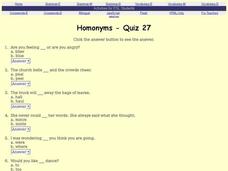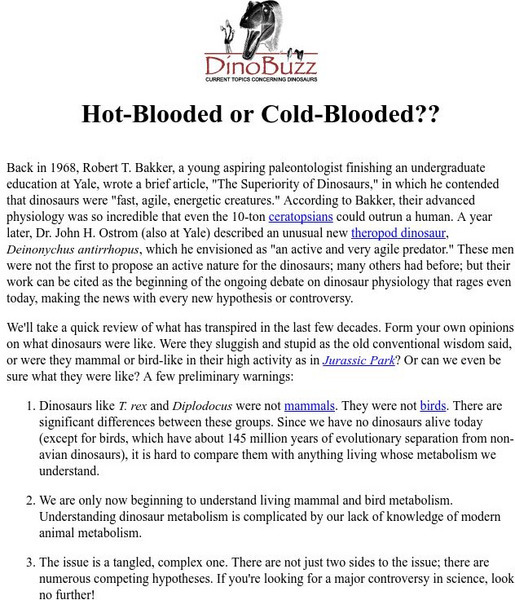Curated OER
Lizard and Bullfrog
In this science worksheet, students compare a lizard and an amphibian. They answer several short questions and color in the pictures.
Curated OER
Radical Reptiles
In this reptiles learning exercise, learners read about reptiles and then answer 10 questions about what they just learned. The answers are on the last page.
Curated OER
Turtle Fun Facts
In this turtles worksheet, students read two pages of facts about turtles. Students match four kinds of turtle pictures to their habitats.
Curated OER
Fearsome Creatures 1
In this wild animals instructional activity, students fill in the blanks or choose the correct words to sentences about wild animals. Students complete 47 blanks.
Curated OER
The Bottlenose Dolphin: Reading Comprehension
In this comprehension activity, students read a selection about the Bottlenose Dolphin, then answer 5 multiple choice questions. Answers provided.
Curated OER
Animal Brochures
Fourth graders work in pairs to research an animal. They fill in an animal data form in order to become experts about the animal they choose. They use the listed criteria to design a six sided brochure that includes graphics of the...
Curated OER
Animals Spiral Puzzle
In this animal puzzle worksheet, students use a set of 8 clues about animals to complete a spiral puzzle. A reference web site is included for additional activities.
Curated OER
Animal Classification
Young scholars classify animals. In this animal classification lesson, students identify characteristics from each of the 5 categories of vertebrates. Young scholars group animals by categories.
Curated OER
Learning about Snakes- Non-Fiction Reading Comprehension Worksheet
In this snakes non-fiction reading comprehension worksheet, 3rd graders read a one page selection about the characteristics of snakes. They complete a table which compares snakes to mammals, and fill in the blanks in 5 questions using...
Curated OER
Outdoor Survival
Students are introduced to basic outdoor survival concepts. They identify the seven basic needs for survival. Students describe the symptoms and treatment for frostbite and hypothermia. They compare and contrast the value of different...
Curated OER
Preventing Hypothermia
Students identify the causes of hypothermia. In this biology lesson, students investigate the different types of heat transfer and heat loss. They discuss several practical measures to avoid hypothermia.
Curated OER
Baleen Whales vs. Toothed Whales
Second graders review mammal characteristics and study two types of whales. In this mammal study lesson, 2nd graders discuss mammals and define their five characteristics. Students complete a whale worksheet and define differences...
Curated OER
The Chordates
Students study the characteristics of organisms that are a part of the phylum Chordata. In this organisms lesson plan students identify mammals that are native to Saskatchewan.
Curated OER
Habitat Hopscotch
Students analyze different habitats. In this habitat lesson, students evaluate what animals need in their habitats. Students participate in the game Habitat Hopscotch.
Curated OER
Animal Behavior: "Groggy Goldfish"
Students observe goldfish in different environments. In this biology lesson plan, students watch the behavior of goldfish in water of varying temperatures.
Curated OER
Homonyms - Quiz 27
In this online interactive ESL worksheet, students respond to 20 fill in the blank questions regarding homonyms. Students may submit their answers to be scored.
Curated OER
Biology Quiz
For this biology worksheet, students complete short answer questions about botany, animals, plants, DNA, and more. Students complete 15 short answer questions.
Curated OER
Go With the Flow!
Students experiment with heat transfer in a countercurrent system and describe the importance of conduction in heat-energy transfer.
Scholastic
Scholastic News: Were Dinosaurs Warm or Cold Blooded?
Scientists have never known if dinosaurs should be called warm-blooded or cold-blooded animals. Learn about the surprising new discovery that has shed light on the answer to this question.
University of California
Ucmp: Hot Blooded or Cold Blooded?
An easy-to-understand explanation of what it means to either hot- or cold-blooded.
California Institute of Technology
Infrared Zoo Lesson 3: The Invisible Zoo
How do biologists and zoologists use infrared technology to learn how warm and cold-blooded animals thermoregulate their internal body temperature? Have your students explore this phenomenon using this great lesson plan.
Bill Nye
Bill Nye: Temperature Time Warp
This tutorial by Bill Nye explains why cold-blooded creatures need a warm environment to survive.
ClassFlow
Class Flow: Vertebrate Flipchart
[Free Registration/Login Required] This flipchart introduces students to vertebrates and provides pictures and information on the different types of vertebrates including their characteristics, their physical and environmental needs, and...
Bill Nye
Bill Nye: Temperature Time Warp
In this activity, learners explore the behavior of cold-blooded animals by observing what happens when they change a fly's temperature.
Other popular searches
- Cold Blooded Warm Blooded
- Colds Warm Blooded Animals
- Warm and Cold Blooded Animals
- Cold Blooded Warm Blooded
- Cold Warm Blooded






















